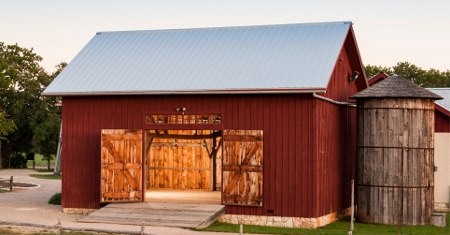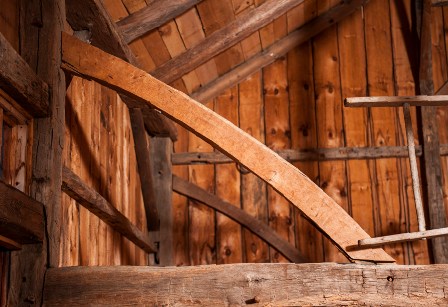
We found the LaRue barn through a phone call from a woman in northern New Jersey who had heard about our work of moving and restoring barns. She wanted to know if we would possibly want to move an old barn that was in danger of being demolished to make way for a new suburban development.
At the time this was only our second barn to move, so we did not know entirely what we were getting into, except that we wanted to restore more barns. As it turned out, this unique barn was originally built about 1760 in the northern New Jersey town of Mahwah, close to the New York state border on Route 202, an old Colonial road that runs from Boston to Philadelphia, skirting to the west around New York City. It is what is known as an English-framed barn, though the LaRue family who built it was of French Huguenot descent. The timbers are oak and chestnut, felled by ax from the surrounding virgin forest and hewed by hand. It was moved in 1876 to where we found it, about a half mile from its original location. Moving barns was a common occurrence, as they were meant to last for centuries and could be readily unpegged, disassembled and relocated to another farm.
Crooked Braces
As you look overhead in the LaRue barn you will see unusual curved and dovetailed wind braces connecting the long overhead tie beams to the outside wall posts. These are called “crooked braces” because they were cut from the crook or curved limb of a tree. This feature is unusual to find in an American barn because there was so much good, straight wood available for building timbers that it was not necessary to use such curved pieces of wood. The use of such tree “crucks” indicates that the barn was probably built by a barn framer who learned his trade in Europe, where crucks were often used due to the shortage of straight timber.

A Role in the American Revolution
Early in its history, the LaRue barn played a role in the American Revolution. During the cold winter of 1780, General George Washington spent two days at the LaRue house, and undoubtedly Continental soldiers under General Washington spent nights in this barn. The soldiers would have been part of a Virginia regiment of “light horse” cavalry under the command of Colonel George Baylor, and were also known as Washington’s “Life Guard,” soldiers whose job it was to protect the commander-in-chief. They accompanied Washington wherever he traveled. It was not far from this barn in 1778, when temporarily detached from the main army, that Colonel Baylor and his cavalrymen were sleeping in barns and were massacred by a British surprise attack in the middle of the night. It was part of a deadly rivalry fomented by a young British officer and spy, Major John Andre, who was later hanged as Benedict Arnold’s accomplice in attempting to sell the important American fort of West Point to the British.
We can imagine these soldiers’ conversation about the war and their families as they settled down in the barn loft for the night. But one thought that definitely did not cross their minds was the fact that one day, over two hundred and twenty years later, some young men from a place called Texas would come to New Jersey and dismantle the barn they were sleeping in and move and rebuild it nearly two thousand miles away—much less that they would fly through the air to get there! We can also most likely claim that “George Washington’s horse slept here!”
We have placed the LaRue barn with a log cabin in a small homestead setting. They are a combination of homestead elements from different times and places: a 1760 New Jersey barn, an 1830 Missouri cabin, an 1860 New York smokehouse, an 1890 New York silo and a 1930 Texas windmill. Yet somehow they all complement one another. If you can, visit in the late afternoon as the sunset casts a golden light across the fields and over the homestead.

Thanks for the history lesson. Also I can read that you love American history, thus you love America. We must maintain our America, and show future generations how great she has been and can be. Thanks again!!!!!
Mike,
Thank you for your comments. Barns like the LaRue have an interesting history. We are also looking forward to publishing an article on the history of another restored building, the Palatine House, in the next issue of the SustainLife journal. There is much to appreciate regarding the agrarian heritage that we’ve received, along with many of the freedoms that we experience today. Having a knowledge of history is important not only because it helps give us this appreciation, but also because from it, we can learn much that will help us in both the present and the future.